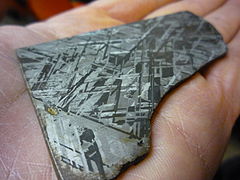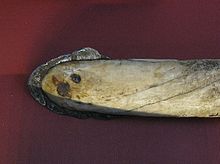隕鐵
| 隕鐵(天然鐵) | |
|---|---|
 由錐紋石和鎳紋石兩種鐵-鎳合金形成的魏德曼花紋 | |
| 基本資料 | |
| 類別 | 天然元素礦物 |
| 化學式 | 不同比率的鐵和鎳 |
| 晶體空間群 | 不同的結構 |
| 性質 | |
| 光澤 | 金屬 |
| 透明性 | 不透明 |
隕鐵(Meteoric iron有時拚寫成meteoritic iron)[1]是在隕石內發現,由天然金屬的鐵和鎳為主形成的礦物,主要的形式是錐紋石和鎳紋石。隕鐵構成了鐵隕石的大部分,並且也出現在其他的隕石中。除了少量的地生鐵,隕鐵是唯一在地球表面可以找到的天然原生金屬元素。
礦物學
[編輯]大部分的隕鐵包含鎳紋石和錐紋石。鎳紋石是面心立方體,錐紋石是體心立方體的鐵-鎳合金。
可以從化學上很好的區分隕鐵和地生鐵,地生鐵的鎳含量低,而碳含較量高[來源請求]。
追蹤隕鐵中鎵和鍺的含量可以區分出不同類型的隕石。石鐵隕石的隕鐵與鐵隕石相同的,被歸類為鐵隕石的"鎵鍺集團"[2]。
| 礦物 | 化學分子式 | 鎳 (質量-% Ni) | 晶體結構 | 註解和參考 |
|---|---|---|---|---|
| Antitaenite | γLow Spin-(Ni,Fe) | 20-40 | 面心立方體 | IMA已承認為鎳紋石的一種品種。 |
| 錐紋石 | α-(Fe,Ni); Fe0+0.9Ni0.1 | 5-10 | 體心立方體 | 結構與鐵酸鹽相同 |
| 鎳紋石 | γ-(Ni,Fe) | 20-65 | 面心立方體 | 結構與奧氏體相同 |
| Tetrataenite | (FeNi) | 48-57 | 正方的 | [3] |
結構
[編輯]隕鐵有幾種不同的結構,可以通過隕石的薄片或蝕刻看到。魏德曼花紋是隕鐵的錐紋石冷卻時從鎳紋石的鱗片中轉化出來形成[4]。合紋石是這兩種礦物在魏德曼花紋的鱗片中共生形成更細微的構造[5]。諾伊曼線是錐紋石晶體經由撞擊等影響造成的變形細線[6]。
文化和歷史的對待
[編輯]
在冶煉鐵出現之前,除了少量大地鐵之外,鐵隕石是鐵金屬的唯一來源。隕鐵在鐵器時代之前已經用來製作文物、工具和武器[7]。
在古埃及格爾津附近墓地發現的金屬鐵顆粒有7.5%的鎳[8][9],在圖坦卡蒙的墓穴裏發現一把由隕鐵製成的匕首[10]。
幾個世紀以來,納瑪人都在使用吉丙隕石的碎片。 在西藏,也有使用它們製作各種不同器物的報告(參見護身符,Thokcha),包括鐵人、多聞天王的雕像,都是用鐵隕石雕刻的[14]。在紀元前1,000年,藏傳佛教的雕像,鐵人,用來雕刻的鐵隕石可能是無紋隕鐵;它甚至可能是辛加隕石的碎片[15][16]。
甚至在冶煉發明之後,隕鐵還是使用這項技術時不可或缺的稀有金屬。在1854年,有一塊克蘭本隕石被製成一隻馬蹄鐵[17]。
今天,隕鐵用在有利可圖的珠寶和裝飾刀上,但大部分用於研究、教育或收藏的目的。
大氣現象
[編輯]隕鐵對地球的大氣也有影響。當隕石穿過大氣層下降時,外面的部分會燒蝕。流星的燒蝕是上層大氣層中許多元素的來源,當隕鐵燒蝕時會形成自由的鐵原子,可以與臭氧作用形成氧化亞鐵(FeO)。氧化鐵是高層大氣中橙色頻譜帶的來源[18]。
相關條目
[編輯]參考資料
[編輯]- ^ Rehren T, et al., "5,000 years old Egyptian iron beads made from hammered meteoritic iron", Journal of Archaeological Science 2013 text (頁面存檔備份,存於互聯網檔案館)
- ^ Lovering, John F.; Nichiporuk, Walter; Chodos, Arthur; Brown, Harrison. The distribution of gallium, germanium, cobalt, chromium, and copper in iron and stony-iron meteorites in relation to nickel content and structure. Geochimica et Cosmochimica Acta. 31 December 1956, 11 (4): 263–278. doi:10.1016/0016-7037(57)90099-6.
- ^ Clarke, Roy S.; Edward R. D. Scott. Tetrataenite - ordered FeNi, a new mineral in meteorites (PDF). American Mineralogist. 1980, 65: 624–630 [13 December 2012]. (原始內容存檔 (PDF)於2015-02-26).
- ^ Yang, J.; J. I. Goldstein. The formation of the Widmanstätten structure in meteorites. Meteoritics & Planetary Science. 2005, 40 (2). doi:10.1111/j.1945-5100.2005.tb00378.x.
- ^ Goldstein, J. I.; J. R. Michael. The formation of plessite in meteoritic metal. Meteorics & Planetary Science. 2006, 41 (4): 553–570. doi:10.1111/j.1945-5100.2006.tb00482.x.
- ^ Rosenhain, Walter; Jean McMinn. The Plastic Deformation of Iron and the Formation of Neumann Lines. Proceedings of the Royal Society. 1925, 108: 231–239. doi:10.1098/rspa.1925.0071.
- ^ Waldbaum, J. C. and James D. Muhly; The first archaeological appearance of iron and the transition to the iron age chapter in The coming of the age of iron, Theodore A. Wertme. ed., Yale University Press, 1980, ISBN 978-0300024258
- ^ Pre-Dynastic Iron Beads from Gerzeh, Egypt. ucl.ac.uk. [28 December 2012]. (原始內容存檔於2015-04-07).
- ^ Rehren, Thilo; Belgya, Tamás; Jambon, Albert; Káli, György; et al. 5,000 years old Egyptian iron beads made from hammered meteoritic iron. Journal of Archaeological Science. 31 July 2013. doi:10.1016/j.jas.2013.06.002.
- ^ Bjorkman, Judith Kingston. Meteors and Meteorites in the ancient Near East. Meteoritics. 1973: 91–132. doi:10.1111/j.1945-5100.1973.tb00146.x.
- ^ Iron and steel in ancient times by Vagn Fabritius Buchwald - Det Kongelige Danske Videnskabernes Selskab 2005
- ^ T. A. Rickard. The Use of Meteoric Iron. Journal of the Royal Anthropological Institute (Royal Anthropological Institute of Great Britain and Ireland). 1941, 71 (1/2): 55–66. JSTOR 2844401. doi:10.2307/2844401.
- ^ Buchwald, V. F. On the Use of Iron by the Eskimos in Greenland. Materials Characterization. 1992, 29 (2): 139–176. JSTOR 2844401. doi:10.1016/1044-5803(92)90112-U.
- ^ Der Lama mit der Hose: „Buddha from space“ ist offenbar eine Fälschung (Telepolis 13.10.2012). [2015-03-14]. (原始內容存檔於2012-12-19).
- ^ Ancient Buddhist Statue Made of Meteorite, New Study Reveals. Science Daily. [26 December 2012]. (原始內容存檔於2015-02-27).
- ^ Buchner, Elmar; Schmieder, Martin; Kurat, Gero; Brandstätter, Franz; et al. Buddha from space-An ancient object of art made of a Chinga iron meteorite fragment*. Meteoritics & Planetary Science. 1 September 2012, 47 (9): 1491–1501. doi:10.1111/j.1945-5100.2012.01409.x.
- ^ The Cranbourne Meteorites (PDF). City of Casey. [29 December 2012]. (原始內容 (PDF)存檔於2013-05-10).
- ^ Evans, W. F. J.; Gattinger, R. L.; Slanger, T. G.; Saran, D. V.; et al. Discovery of the FeO orange bands in the terrestrial night airglow spectrum obtained with OSIRIS on the Odin spacecraft. Geophysical Research Letters. 20 November 2010, 37 (22). doi:10.1029/2010GL045310.
